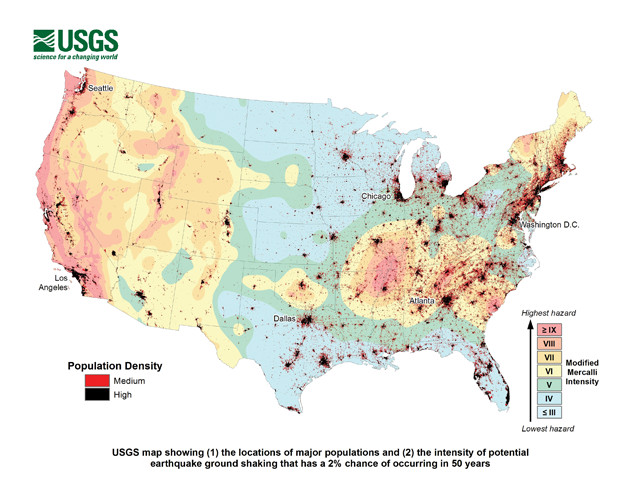
by Timothy Oleson Monday, December 14, 2015

Credit: U.S. Geological Survey.
An estimated 143 million Americans in the conterminous 48 states, or about 46 percent of the population, live in areas susceptible to potentially damaging ground shaking from natural earthquakes, according to a new study by U.S. Geological Survey (USGS) scientists published in the journal Earthquake Spectra. (The study did not assess hazards associated with human-induced quakes.)
“The new exposure estimate is nearly double the previous 2006 estimate of 75 million Americans in 39 states, and is attributed to both population growth and advances in science,” which allow for better hazard assessments, said William Leith, the USGS senior science advisor for earthquake and geologic hazards and a co-author of the study, in a statement.
The population susceptible to “potentially damaging” shaking faces at least a 2-percent chance of experiencing ground motion equivalent to about VI or more on the Modified Mercalli Scale within a 50-year period. (In some areas, the likelihood of this level of shaking is substantially higher than 2 percent.) Meanwhile, 44 million people are at further risk for “very strong” shaking equivalent to about VIII or more occurring with the same odds (2 percent within a 50-year period). States with large populations susceptible to very strong shaking include California, Nevada, Oregon, Washington and Utah, as well as those near known fault zones in the central and southern U.S. like the New Madrid Fault Zone.
The new estimates were compiled using the most recent U.S. National Seismic Hazard Maps combined with high-resolution population data from the LandScan project.
© 2008-2021. All rights reserved. Any copying, redistribution or retransmission of any of the contents of this service without the expressed written permission of the American Geosciences Institute is expressly prohibited. Click here for all copyright requests.